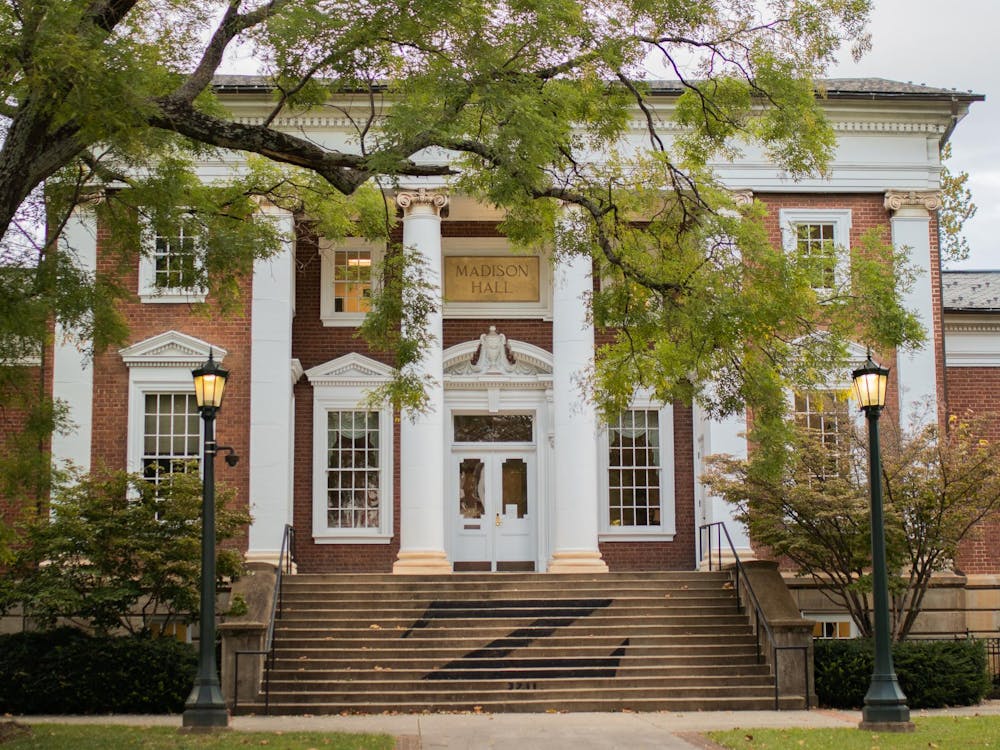University students and members of the Charlottesville community gathered Wednesday night to protest the Staten Island court decision to drop the criminal case against NYPD Officer Daniel Pantaleo, who was charged with the fatal choking of Eric Garner.
Gathering on Mad Bowl, the space between Madison Lane and Rugby Road, the group marched and chanted across Grounds — through Alderman, Clemons and Brown libraries, Newcomb Hall, and ending on the doorstep of Carr's Hill — calling for increased awareness of and resistance against the injustices felt by members of the black community.
Though the Garner case served as the immediate impetus for the protest, leaders said the gathering was less about a particular case, rather focusing on the broad injustice against African Americans — an injustice which includes problems of race-based police brutality.
Protest organizer Kiara Redd-Martin, a graduate student at Norfolk State who grew up in Charlottesville, urged participants to be angry about Garner's killing but not to lose sight of the broader situation.
“Stand up for yourself and stand up for your community,” Redd-Martin said. “We aren’t going to take this, we are going to stand against it — this is about showing our presence.”
Black Student Alliance President Joy Omenyi, a fourth-year College student, said she agreed with this view. Omenyi said that though Garner was the spark for the gathering, the protest’s scope quickly broadened — and the group took to the libraries to protest this larger social injustice in front of a group which may come in contact with the BSA less regularly.
Second-year College student Aryn Frazier, the Black Student Alliance political action chair, affirmed that the protest aimed its message at people with whom the BSA is not typically able to interact.
“For a lot of the things we do, people have to come to us — the bulk of the crowd are people that come willingly,” Frazier said. “This [protest] brought the issue to people. One of large chants was, ‘No justice, no peace.’ If these are things that we have to think about — that black students have to fear that ‘they’re the next one’ — all people should recognize this.”
The original plan for the rally had been to march from Mad Bowl to the Corner to attract the attention of students and the community. Realizing, however, most students would be studying for finals instead of out on the Corner, libraries represented an opportunity to cause impactful disruptions for a large population of students, Omenyi said.
“The protest was most powerful on the first floor [of Clemons], because it was the quietest floor,” Omenyi said. “We were down there for 15 minutes.”
University NAACP Chapter President VJ Jenkins, second-year College student, said action such as the protest will inspire greater interest and investment, and that he has already seen a positive impact from this event.
“By going to the library today, it shook a group of people who don’t necessarily usually take an interest in the cause to witness this,” Jenkins said. “While we were protesting, I saw students start to research and look into this — it’s really important that people do this.”
Protesters hoped to garner more than just student recognition, however. The group also looked to generate a deeper investment in the black community from the University administration and University President Teresa Sullivan.
Omenyi, Frazier and Jenkins said the administration is not interested in the University's black population. Omenyi referenced the disparity she sees in the information sent to the undergraduate body in University emails.
“It’s been very obvious that we’ve been frustrated with this issue [of inequality] all semester — we’ve been having rallies, vigils, protests, and we have yet to be acknowledged,” Omenyi said. “We get an email about robbery off of Grounds but not about [a] death on Grounds — about Emmanuel Brown, a black man working at the University.”
Jenkins attributed this to what he perceives as Sullivan’s apathy toward the black student community.
“If a black student were to die, [Sullivan] would ask Dean [Maurice] Apprey — Dean of the Office of African American Affairs — to send an email,” Jenkins said.
Protesters ended their march on the steps of Carr’s Hill, chanting, “Where’s our email?” Despite all the emails the student body has received from the President’s Office this semester, Frazier said none have addressed the issues currently affecting the black community.
Omenyi said the protest was a success. In addition to a larger-than-expected turnout, the group said it had already seen a lot of positive social media attention.
“There’s beauty in seeing a community come together,” Jenkins said. “That’s what I think the nation’s been seeing [and] that’s definitely what we saw here tonight — it touched me.”
Students who gathered at Mad Bowl said the group formed in solidarity with a vision of coming together, and viewed the problem addressed in the protest as, in many ways, a national issue.
Third-year College student Kelly Carson said the Garner case reflects a systemic problem "with the American psyche."
“I’m asking for people to wake up and look at recent cases and police brutality in every community,” she said.
Second-year College student Nqobile Mthethwa agreed, saying the American justice system as a whole is at fault.
“We watched a murder, and our justice system let [Pantaleo] free without any charges,” Mthethwa said.
At Carr’s Hill, demonstrators discussed the potential of continuing protests tomorrow at Lighting of the Lawn. Omenyi said she and others are not currently planning additional demonstrations this semester.







